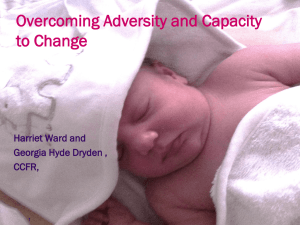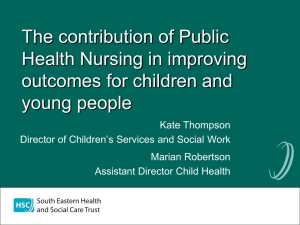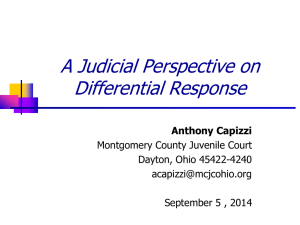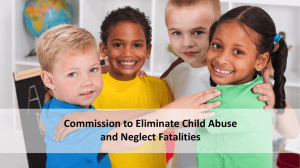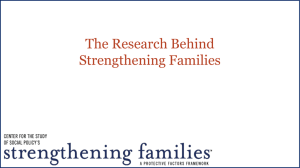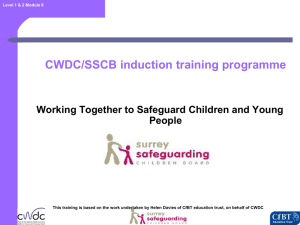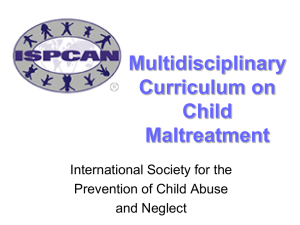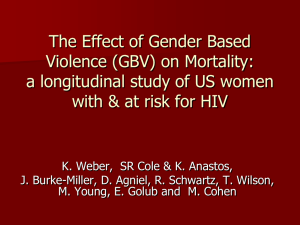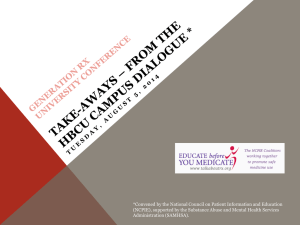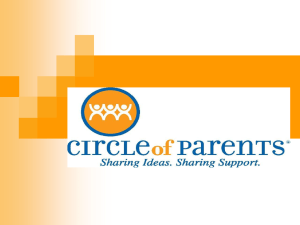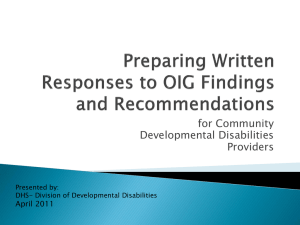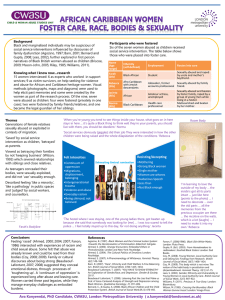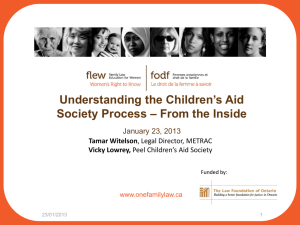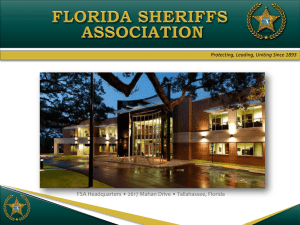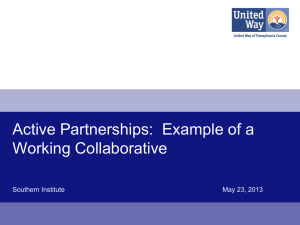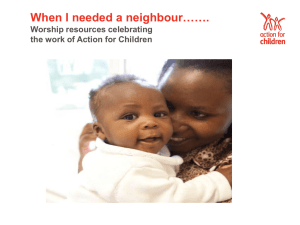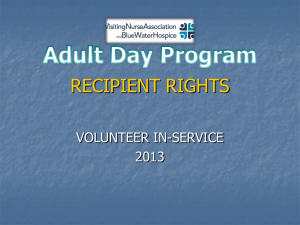Child Abuse History
advertisement
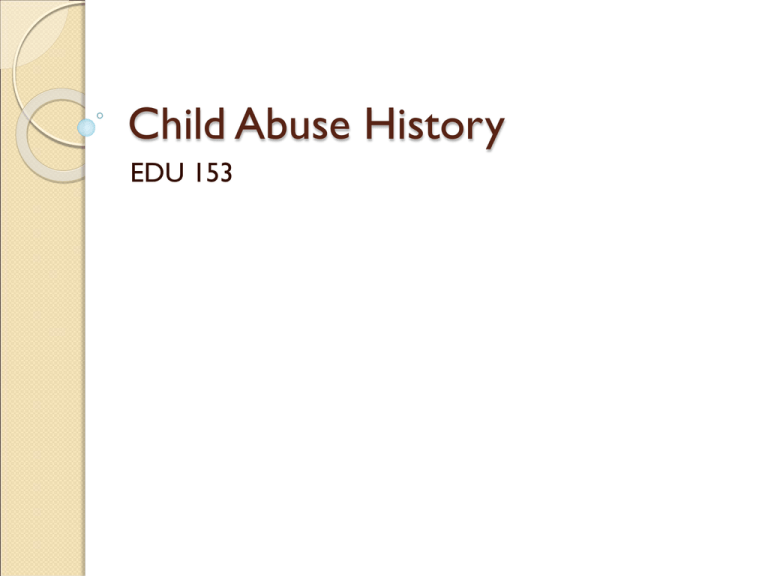
Child Abuse History EDU 153 Child Maltreatment Crisis The problem of child maltreatment in the United States, and around the world as well, has reached crisis proportions. At a special meeting at the National Center for Child Abuse and Neglect in Washington DC in July of 1990, a special federal panel declared the maltreatment of children a national emergency. This was not always the case. A child's right to be free from inhumane treatment has been recognized only recently. Child abuse and neglect is not a new problem. Child abuse and neglect have occurred throughout history but it is only within the last 40 years that public attention has been drawn to the problem. Child Maltreatment Over the centuries, infanticide ritual sacrifice, and exploitation of child labor are only some of the ways children have been mistreated. In many societies children had no rights or privileges including the right to live. ◦ In Greece in 4th Century BC a child was the property of the father who decided whether the child lived or died on the fifth day after birth. ◦ According to ancient Roman law the father had the power of life and death over children that extended into adulthood. ◦ Early English common law entitled the custody of children to the father. Children were regularly sacrificed as part of religious and other cultural rituals in early societies of Africa, Asia, North and South America and Australia as well as Europe. Unwanted infants - often the malformed, handicapped, or female children - were abandoned in temples for the gods to care for, which really meant they were left to die from exposure or dehydration. Many were simply discarded or thrown into rivers or sewers. The practices were accepted as a matter of course well into the first century AD and vestiges of those practices were common even in the 19th century England and in post Civil War United States. The era of the Industrial Revolution was particularly hard on children. Many poor children were used as forced cheap labor in the factories in England. ◦ It was common practice to tie or chain the children to their stations and whip them to ensure the amount of productivity the mill owners desired. ◦ Poorly fed and housed many of these children did not survive into adulthood. ◦ In the United States children did not fare much better. John Walker One of the earliest child abuse cases was recorded in Massachusetts in 1655. A 12 yr. old boy, John Walker was an apprentice who was mistreated by his master and died. His master was convicted of manslaughter and was ordered burned in his hands; all his goods were confiscated. Mary Ellen Wilson The NY case of Mary Ellen Wilson was one of the first cases in this country to attract widespread attention through the press in 1874. Etta Wheeler, hearing from concerned friends and neighbors that a nine year old child was being beaten daily in a tenement on the Upper East Side of New York City. Ms. Wheeler entered the apartment and found a little girl, Mary Ellen, seriously malnourished, bruised, and tied to her bed. The child reported to the worker that she was never allowed outside the apartment. She was often locked in the closet for long periods of time. Mary Ellen The worker appealed to the police, the district attorney, and other law enforcement officials, but they could take no action. There were no laws under which they could initiate a legal proceeding. ◦ Children were considered to be the chattel or goods of their parents or caretakers. ◦ Parents had very broad latitude over the manner in which they fed, clothed, and disciplined them. SPCA In desperation Etta Wheeler approached an official of the Society for the Prevention of Cruelty to Animals (SPCA) which had been formed a few years earlier. Mary Ellen was taken to court by them on a stretcher. Mary Ellen The attorney for the SPCA argued before the court that the child was a member of the animal kingdom, and as such should be afforded the same rights and protection of animals which were already in the state laws regarding their humane treatment. Her adoptive parents were found guilty of cruelty to animals. Mary Ellen Wilson was the first child taken away from abusive/negligent caretakers by court order in the United States. Mary Ellen was removed from the home and placed in foster care, an action which probably saved her life. The Society for the Prevention of Cruelty to Children was formed the following year. Dr. C. Henry Kempe, national conference in 1961 ◦ Symposium on Child Abuse pediatric radiologist, who had been studying children's injuries and various aspects of child abuse, first introduced the phrase "battered child syndrome.“ For the first time doctors and other medical professionals accepted the premise that much of the unexplained trauma in children was the result of actions by their parents or caretakers. Child Abuse Reporting Laws This symposium on Child Abuse led to the proposal of child abuse reporting laws. It required physicians to report cases to police authorities. Physicians were given immunity from civil or criminal; liability and failure to report was a misdemeanor. Child Abuse Prevention and Treatment Act January 31, 1974, (Public Law 93-247) signed into law creating the National Center on Child Abuse and Neglect. The law required states to establish definitions, policies, procedures and laws regarding child abuse and neglect. ◦ It required each state to appoint an agency, and grant it legal authority to investigate and prosecute incidences of maltreatment. In 1965 NC enacted the state's first reporting law; reporting was voluntary. In 1971, the law was changed; reporting became mandatory. Reporting Child Abuse/Neglect § 7B-301. Duty to report abuse, neglect, dependency, or death due to maltreatment. Any person or institution who has cause to suspect that any juvenile is abused, neglected, or dependent, as defined by G.S. 7B-101, or has died as the result of maltreatment, shall report the case of that juvenile to the director of the department of social services in the county where the juvenile resides or is found. The report may be made orally, by telephone, or in writing. The report shall include information as is known to the person making it including the name and address of the juvenile; the name and address of the juvenile's parent, guardian, or caretaker; the age of the juvenile; the names and ages of other juveniles in the home; the present whereabouts of the juvenile if not at the home address; the nature and extent of any injury or condition resulting from abuse, neglect, or dependency; and any other information which the person making the report believes might be helpful in establishing the need for protective services or court intervention. If the report is made orally or by telephone, the person making the report shall give the person's name, address, and telephone number. Refusal of the person making the report to give a name shall not preclude the department's investigation of the alleged abuse, neglect, dependency, or death as a result of maltreatment. Reporting Child Abuse/Neglect This law requires everyone to report suspected Child Abuse or neglect. This reporting requirement applies to professionals such as physicians, psychologists, other health and mental health workers and school and day care personnel. But it applies equally to friends, neighbors, relatives and anyone else who suspects that a Child is abused or neglected. The law makes no exceptions to the reporting requirement-- not even for the doctor-patient or other relationships that usually involve confidentiality. The reporting law only requires that a person have a reasonable suspicion that a Child is being mistreated., not that he or she is certain or actually knows that Abuse or neglect exists. If in doubt report! There is a statute that provides immunity from civil or criminal liability for anyone who in good faith makes a report of suspected Child abuse or neglect. ◦ Obviously this law cannot prevent a parent from bringing suit against those who report but it is highly unlikely that such a suit would be successful since the burden is on the person who sues to prove that the reporter acted in bad faith. The consequences of not reporting can include civil as well as criminal liability.

